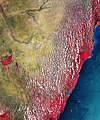File:Earth from Space- Southeast Kenya ESA25993536.tiff

Original file (11,559 × 13,851 pixels, file size: 458.09 MB, MIME type: image/tiff)
Captions
Captions
Summary
[edit]| Warning | The original file is very high-resolution. It might not load properly or could cause your browser to freeze when opened at full size. | Open in ZoomViewer |
|---|
| DescriptionEarth from Space- Southeast Kenya ESA25993536.tiff |
English: The striking contrast of the diverse landscape in southeast Kenya is featured in this false-colour image captured by Copernicus Sentinel-2. Zoom in to explore this image at its full resolution or click on the circles to learn more. The Republic of Kenya lies in East Africa and is renowned for its scenic natural landscapes and vast wildlife reserves. Its low coastal plain facing the Indian Ocean holds some of Africa’s finest beaches, which, in the image, can be seen as light brown strips all along the coast. A few natural inlets are visible in shades of blue along the coast. Mombasa, Kenya’s chief port and second largest city, lies on the large inlet at the bottom of the image. The popular tourist town of Malindi can be spotted as a grey area on the coast about 120 km northeast of Mombasa, at the mouth of the Athi-Galana-Sabaki River, Kenya’s second longest river. The river course can be seen across the top left of the image. It flows in a southwest direction and eventually drains into the Indian Ocean. This false-colour image has been processed including Copernicus Sentinel-2’s near-infrared channel. This type of band combination is most commonly used to assess plant density and health, as plants reflect near-infrared and green light, while absorbing red. Since they reflect more near-infrared than green, dense, plant-covered land appears in bright red. The red strip of land along the coast denotes heavily vegetated areas, including various natural reserves and parks. This contrasts with the green and yellow areas of the hinterland, which conversely appear relatively devoid of vegetation. A layer of ‘popcorn’ clouds spreads evenly over the vegetated areas along the coast. These clouds are the result of water vapour that has evaporated from trees and other plants. As the air rises, it cools and the water vapour condenses into the tiny clouds as are visible here. |
| Date | 22 March 2024 (upload date) |
| Source | Earth from Space: Southeast Kenya |
| Author | European Space Agency |
| Other versions |
|
| Activity InfoField | Observing the Earth |
| Mission InfoField | Sentinel-2 |
| Set InfoField | Earth from Space image collection |
| System InfoField | Copernicus |
Licensing
[edit]
|
This image contains data from a satellite in the Copernicus Programme, such as Sentinel-1, Sentinel-2 or Sentinel-3. Attribution is required when using this image.
Attribution: Contains modified Copernicus Sentinel data 2023
Attribution
The use of Copernicus Sentinel Data is regulated under EU law (Commission Delegated Regulation (EU) No 1159/2013 and Regulation (EU) No 377/2014). Relevant excerpts:
Free access shall be given to GMES dedicated data [...] made available through GMES dissemination platforms [...].
Access to GMES dedicated data [...] shall be given for the purpose of the following use in so far as it is lawful:
GMES dedicated data [...] may be used worldwide without limitations in time.
GMES dedicated data and GMES service information are provided to users without any express or implied warranty, including as regards quality and suitability for any purpose. |
Attribution
This media was created by the European Space Agency (ESA).
Where expressly so stated, images or videos are covered by the Creative Commons Attribution-ShareAlike 3.0 IGO (CC BY-SA 3.0 IGO) licence, ESA being an Intergovernmental Organisation (IGO), as defined by the CC BY-SA 3.0 IGO licence. The user is allowed under the terms and conditions of the CC BY-SA 3.0 IGO license to Reproduce, Distribute and Publicly Perform the ESA images and videos released under CC BY-SA 3.0 IGO licence and the Adaptations thereof, without further explicit permission being necessary, for as long as the user complies with the conditions and restrictions set forth in the CC BY-SA 3.0 IGO licence, these including that:
See the ESA Creative Commons copyright notice for complete information, and this article for additional details.
|
 | |
This file is licensed under the Creative Commons Attribution-ShareAlike 3.0 IGO license. Attribution: ESA, CC BY-SA IGO 3.0
| ||
File history
Click on a date/time to view the file as it appeared at that time.
| Date/Time | Thumbnail | Dimensions | User | Comment | |
|---|---|---|---|---|---|
| current | 00:20, 28 March 2024 |  | 11,559 × 13,851 (458.09 MB) | OptimusPrimeBot (talk | contribs) | #Spacemedia - Upload of https://esamultimedia.esa.int/img/2024/03/Malindi-Mombasa_S2_20231002_20m_843_enhanced.tif via Commons:Spacemedia |
You cannot overwrite this file.
File usage on Commons
The following page uses this file:
Metadata
This file contains additional information such as Exif metadata which may have been added by the digital camera, scanner, or software program used to create or digitize it. If the file has been modified from its original state, some details such as the timestamp may not fully reflect those of the original file. The timestamp is only as accurate as the clock in the camera, and it may be completely wrong.
| Width | 11,559 px |
|---|---|
| Height | 13,851 px |
| Bits per component |
|
| Compression scheme | Uncompressed |
| Pixel composition | RGB |
| Image data location | 28,522 |
| Orientation | Normal |
| Number of components | 3 |
| Number of rows per strip | 13,851 |
| Bytes per compressed strip | 480,311,127 |
| Horizontal resolution | 72 dpi |
| Vertical resolution | 72 dpi |
| Data arrangement | chunky format |
| Software used | Adobe Photoshop 25.5 (Windows) |
| File change date and time | 11:15, 19 March 2024 |
| Color space | Uncalibrated |


